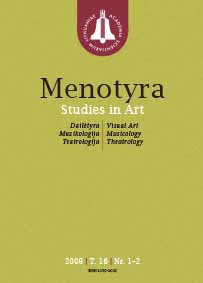Antikiniai mathesis kaip garsų meno grožio aspektai
Aspects of ancient mathesis as the beauty of sound art
Author(s): Rima PovilionienėSubject(s): Music, Aesthetics
Published by: Lietuvos mokslų akademijos leidykla
Summary/Abstract: The article actualises the problem of the interplay between music and mathematics and portrays a wide spectrum of philosophical and aesthetic contacts. We believe that continuous associations between music and mathematics could be determined by the aesthetisation of mathematics as a subject of the philosophy of beauty. The theory of philosopher Aleksei Losev could serve as a fundamental substantiation of the interplay between music and mathematics. According to Aleksei Losev, the foundation of music is logical, i. e. mathematical, and a philosophical interpretation of this foundation reveals the generality which lies in the profundity of music and mathematics. Losev categorically segregated the sound art from music as a conception of a physical or psychological phenomenon (alleging that it was erroneous to analyse music from the affective point of view as a process entailing psychological experiences) and stated that music “may be compared only to the ideal numerical relationship”, because music and mathematics are of the same nature – ideal sui generis (Latin, meaning “of its own kind, “generating from itself”). All what distinguishes music from, and raises it above, mathematics is its being art. The logical thinking of mathematics (mathematics is the construction of the number itself, it speaks about numbers logically) is surpassed by the illogical thinking of music which expresses numbers in an artistic manner, performs expressive and symbolic construction and displays the artistic side of the number. The first trend of the philosophy of music is probably linked to the relationships between music and mathematics. The mathematically based approach of philosophers to-wards music traces back to the 6th century BC and lies in the researches of Pythagorean musical intervals and their numerical equivalents. These are cosmologic observations of the Pythagoreans interpreting musical intervals as a reflection of the composition of the cosmos and the world (numerological relations of musical intervals were regarded as an analogy of the combination of planets, things and human soul), the quadrivium (a Latin word meaning “the four ways” or “the four roads”) formulated in Boethius’ tractate De Institutione Musica, where music is interpreted as a branch of mathematics in one line with arithmetic, geometry and astronomy. The concept of “harmony of the spheres”, as based on the interrelations between sounds and numbers, sent wide-reaching ripples to later epochs, for example, the tractate Harmonices Mundi (“The Harmony of the Worlds”, 1619) by Johannes Kepler (1571–1630). The relationship of micro-and macro-cosmoses and the relational linkage thereof, as provable by means of numerical procedures, is mentioned in the tractate Musurgia Universalis (1650) by Athanasius Kircher (1602–1680) on whose basis the main constant of the aesthetic idea of the German Baroque music is defined as the dependence of music on the cosmological order and its principles, because relationships between the microcosm and the macrocosmos are recorded by musical sounds.
Journal: Menotyra
- Issue Year: 16/2009
- Issue No: 1-2
- Page Range: 1-11
- Page Count: 11
- Language: Lithuanian

